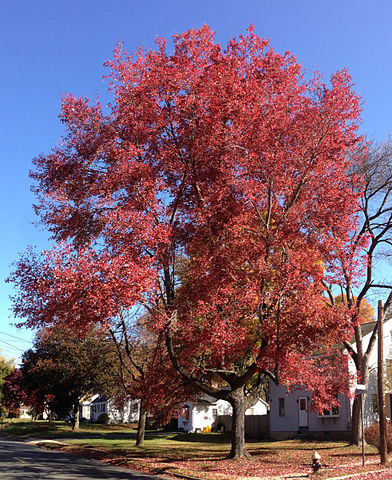
Summary
Trees need sunlight to survive and prosper in any kind of environment. Sunlight is one of the factors that allows for trees to grow in their specific ways creating their distinct crown shapes that can differ from tree to tree even within the same species. The tree crown consists of the leaves and branches that extend outward from the tree's trunk. Without ample amount of access to this necessity, a tree may be less resistant to environmental and human stressors and tree shape will be altered.
Red Maple Tree Crown
What do trees do with sunlight?
Trees use energy from the sun to create sugars through a process called photosynthesis and without these sugars as an energy source a tree cannot grow or ultimately survive. A study by Thomas Givnish found that the process of photosynthesis is directly impacted by the amount of sunlight that hits a tree's leave. Trees compete for sun exposure and some species will ultimately be shaded by others, causing the shaded species to decrease photosynthesis rates due to less availability of sunlight. In another study, led by Rafael de Casas, researchers found that photosynthetic processes have a large effect on what a tree crown looks like. These researchers found that leaves along the outer regions of a tree crown get more sun and are larger. This distribution creates a layered affect within the tree crown giving it its distinct shape. Having a decrease in photosynthetic processes can be hazardous to multiple structures of the tree causing tree shape to change.
Why is tree shape important?
The crown of a tree is what we see as the distinct shape of trees. Crown shape was determined to be very important to overall tree productivity in a study led by Pauline Stenberg. Researchers calculated productivity by the amount of sunlight a tree absorbed and then compared it to the volume of the tree crown. As the volume of the crown increased it further increased the amount of sunlight absorbed leading to an increase in photosynthetic processes which results in a healthier, stronger tree. Another study looked closely at which parts of the tree crown were responsible for the increase in sunlight absorption, photosynthetic processes, and the movement of water through a plant (known as transpiration). It found that the total area of the leaves and how the leaves were distributed throughout the tree crown were the most important in increasing all three factors of sunlight absorption, photosynthetic processes, and transpiration.

Photosynthesis Process
References
de Casas, R., Vargas, P., Pérez-Corona, E., Manrique, E., García-Verdugo, C., & Balaguer, L. (2011). Sun and shade leaves of Olea europaea respond differently to plant size, light availability and genetic variation. Functional Ecology, 25(4), 802-812. doi: 10.1111/j.1365-2435.2011.01851.x
Givnish, T. (1988). Adaptation to Sun and Shade: a Whole-Plant Perspective. Australian Journal Of Plant Physiology, 15(2), 63. http://www.publish.csiro.au/fp/PP9880063
Kocher, S., & Harris, R. (2007). Tree Growth and Competition (5th ed., pp. 3-5). University of California: Division of Agriculture and Natural Resources. Retrieved from http://anrcatalog.ucanr.edu/pdf/8235.pdf
Stenberg, P., Kuuluvainen, T., Kellomäki, S., Grace, J. C., Jokela, E. J., & Gholz, H. L. (1994). Crown structure, light interception and productivity of pine trees and stands. Ecological Bulletins, 20-34. http://www.jstor.org/stable/20113129
Wang, Y. P., & Jarvis, P. G. (1990). Influence of crown structural properties on PAR absorption, photosynthesis, and transpiration in Sitka spruce: application of a model (MAESTRO). Tree physiology, 7(1-2-3-4), 297-316. https://www.ncbi.nlm.nih.gov/pubmed/14972925
Image Credits
Red Maple Tree Crown: "Red Maple during autumn on Lower Ferry Road in Ewing, New Jersey" by Famartin, licensed under CC BY-SA 4.0
Photosynthesis process:"Photosynthesis.gif" by At09kg, licensed under CC BY-SA 3.0